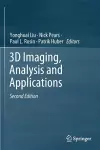
3D Imaging, Analysis and Applications
4 contributors - Paperback
£69.99
Dr Yonghuai Liu is a full professor and the director of the Visual Computing Lab at Edge Hill University since 2018. He started in September 2001 as a lecturer and then became a senior lecturer in 2011 at Aberystwyth University. He obtained his first PhD degree in 1998 from Northwestern Polytechnical University, P.R. China and second PhD degree in 2001 from The University of Hull, United Kingdom. He is currently an area/associate editor, and editorial board member for various international journals and conference proceedings such as Pattern Recognition Letters, Neurocomputing, American Journal of Educational Research, and IEEE International Conference on Robotics and Automation (ICRA). He won several international awards such as the best associate editor award as an associate editor for the Proceedings of ICRA, 2017. He has published four books and more than 190 papers in top ranked international conference proceedings and journals. His primary research interests lie in 3D computer vision, image processing, pattern recognition, machine learning, artificial intelligence, and intelligent systems. He is a senior member of IEEE, Fellow of British Computer Society and Fellow of Higher Education Academy of United Kingdom.
Nick Pears is an Associate Professor in Computer Science at the University of York, UK. He works in Computer Vision and Machine Learning - particularly medical, biometric and creative applications that employ statistical 3D shape modelling. He was recently awarded a Senior Research Fellowship award by the Royal Academy of Engineering (UK) and has had his recent work supported by two Google Faculty Awards. Previously he has worked at the University of Cambridge and University of Oxford, UK, and he gained his BSc in Engineering Science and his PhD in Robotics from the University of Durham, UK.
Paul L. Rosin is a Professor at the School of Computer Science & Informatics, Cardiff University. He has worked on many aspects of computer vision over the last 30 years, covering both fundamental algorithms in areas such as low level image processing, performance evaluation, shape analysis, facial analysis, medical image analysis, surveillance, 3D mesh processing, cellular automata and non-photorealistic rendering, as well as multidisciplinary collaborations such as: determining the effectiveness of surgery from facial morphology and temporal dynamics, the perception of trustworthiness from smiles, segmentation of 3D OCT scans of retinas, interpreting lava flows, identification of desmids and otoliths, analysing the effects of alcohol on crowd dynamics and violence, and digitally unrolling of fragile parchments from 3D X-ray scans.
Patrik Huber is an Assistant Professor at the Department of Computer Science of the University of York, UK. His research is focused on computer vision, and in particular, around 3D face reconstruction and 3D face modelling from images and videos. He is interested in statistical face models, face tracking and analysis, inverse rendering, and combining deep learning with 3D face models, and has co-authored several publications in top ranked international conferences and journals in the field. In particular, he is interested in applications of his research in health care and in the creative industries. In 2018, he founded 4dface Ltd, a research-focused small-business specialising in 3D face modelling and 3D face avatars for professional applications. Previously he has worked as a Research Fellow at the Centre for Vision, Speech and Signal Processing of the University of Surrey, UK, where he obtained his PhD degree in 2017 with his work on real-time 3D face model fitting. Before that, he obtained his BSc. and MSc. from the University of Basel, Switzerland.